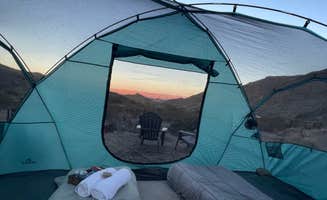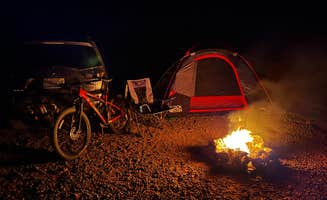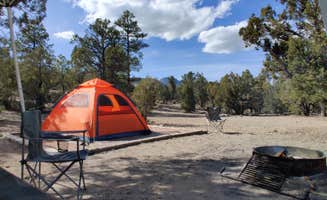Desert camping near Nellis Air Force Base occurs in a rugged landscape with elevations ranging from shoreline Lake Mead sites to high-elevation mountain retreats exceeding 6,000 feet. Temperature differences between locations can reach 25°F, with higher elevation sites providing significant relief during summer months. Tent camping options around Nellis Air Force Base include both primitive dispersed sites and basic designated campgrounds with varying degrees of accessibility.
What to do
Shoreline exploration and water activities: At Eight Mile Dispersed Camping, campers have access to Lake Mead for kayaking and fishing. "We Camp in the roofnest tent ⛺and Kayaking the next morning. What a epic experience," notes Cedric S. The lake access provides opportunities to see fish in the shallows.
Evening stargazing sessions: Desert Pass Campground's elevation and distance from city lights create optimal conditions for astronomy. According to Bronco Billy, "Too many starts to count, you'll be up all night." Higher elevations provide clearer views of constellations with minimal light pollution.
Wildlife observation: The canyons and woodlands surrounding Carpenter Canyon offer opportunities to spot desert wildlife. "There's a beautiful little stream with fish in it!" reports Christie. Morning and evening hours typically provide the best wildlife viewing opportunities when animals are most active.
What campers like
Temperature variations: Mack's Canyon Dispersed Camping provides significant relief from summer heat. Ryan F. explains: "Mack's Canyon Campground is a convenient and easily accessible spot just outside of Las Vegas, making it a popular choice for campers looking for a quick escape from the city." Many campers specifically seek these higher elevation sites during summer months.
Secluded camping spots: Several areas offer isolation from other campers. At Carpenter Canyon, one camper noted, "Didn't see a single person the whole way in and the scenery is very dull until you get into the canyon. But WOW, once you get back there it's amazing." This seclusion creates opportunities for quiet contemplation away from crowds.
Desert landscape diversity: Valley of Fire Dispersed showcases dramatic red rock formations that change color throughout the day. "A great spot before visiting Valley of Fire. Leveled, gravel, Fire pits," states Michał M. The geological features provide natural windbreaks and photography opportunities at sunrise and sunset.
What you should know
Road conditions and vehicle requirements: Most dispersed camping areas require high-clearance vehicles. At Eight Mile Dispersed Camping, Kiley S. warns: "I've driven down other washboard roads but even with some speed this road was so tough on my van... it was a loud, bumpy, stressful 2 mile ride." Many roads deteriorate further after rain events.
Water planning: No running water exists at most sites. Desert Pass Campground campers must prepare accordingly. Dalton S. advises, "There is no running water, cellular service, or firewood, so come prepared." Plan for at least one gallon of water per person per day during summer months.
Seasonal insect considerations: Higher elevation sites experience periodic insect pressure. Niki S. reports about Desert Pass: "We got eaten alive!! It's a beautiful area and the nights were beautiful but never again." Bug activity typically increases after rainfall and during summer months.
Cell service variability: Signal strength varies dramatically by location. At Eight Mile Dispersed Camping, one camper noted, "Cell signal is booming @ this site, more so than Govt Wash which is across the way." Desert Pass has no cellular coverage at all, requiring alternative emergency planning.
Tips for camping with families
Site selection factors: Road Runner Cove offers a combination of water access and shade that works well for families with children. "This place is hard to get to but worth it. It's very isolated and secluded and it surrounded by trees. If you can make it you can camp and have A whole lake to yourself," reports Overland Pioneer. Sites with natural features like tree cover provide shade for daytime activities.
Wildlife watching opportunities: Early morning hours at higher elevations often yield wildlife sightings. When camping at Carpenter Canyon, families can explore the stream area where fish have been spotted. One reviewer mentioned, "There's a beautiful little stream with fish in it!" making this an engaging activity for children.
Heat management strategies: For summer tent camping near Nellis Air Force Base, timing is crucial. Ryan F. notes that Desert Pass provides "cooler mountain air surrounded by beautiful pine and juniper trees. The elevation makes a huge difference in temperature—what feels awful and unbearable in the valley becomes a refreshing and comfortable summer retreat here." Morning hikes and evening activities work best during hot months.
Tips from RVers
Site accessibility limitations: Rugged access roads restrict RV options at most dispersed sites. At Eight Mile Dispersed Camping, Greg L. cautions: "Wide dusty washboard road to access, 2-3 miles. Dumpsters at top by Northshore hwy but nothing later, no toilets or other facilities. I would never haul a trailer in there." RVs under 20 feet have more options than larger rigs.
Leveling challenges: Finding flat spots requires advance planning. According to Daniel G. at Desert Pass, "Each site has a picnic table, fire ring and tent pad," making these established sites more suitable for small trailers than completely dispersed areas. Many campers recommend arriving early to secure the limited level spots.
Wind exposure management: Desert camping near Nellis Air Force Base often means dealing with strong winds. At Valley of Fire Dispersed, the terrain offers limited protection from gusts, which can affect awnings, tents and outdoor cooking. Prepare by positioning vehicles as windbreaks and bringing appropriate stabilization equipment.





